MARIANI’S
Virtual Gourmet
JULY
14, 2019
NEWSLETTER
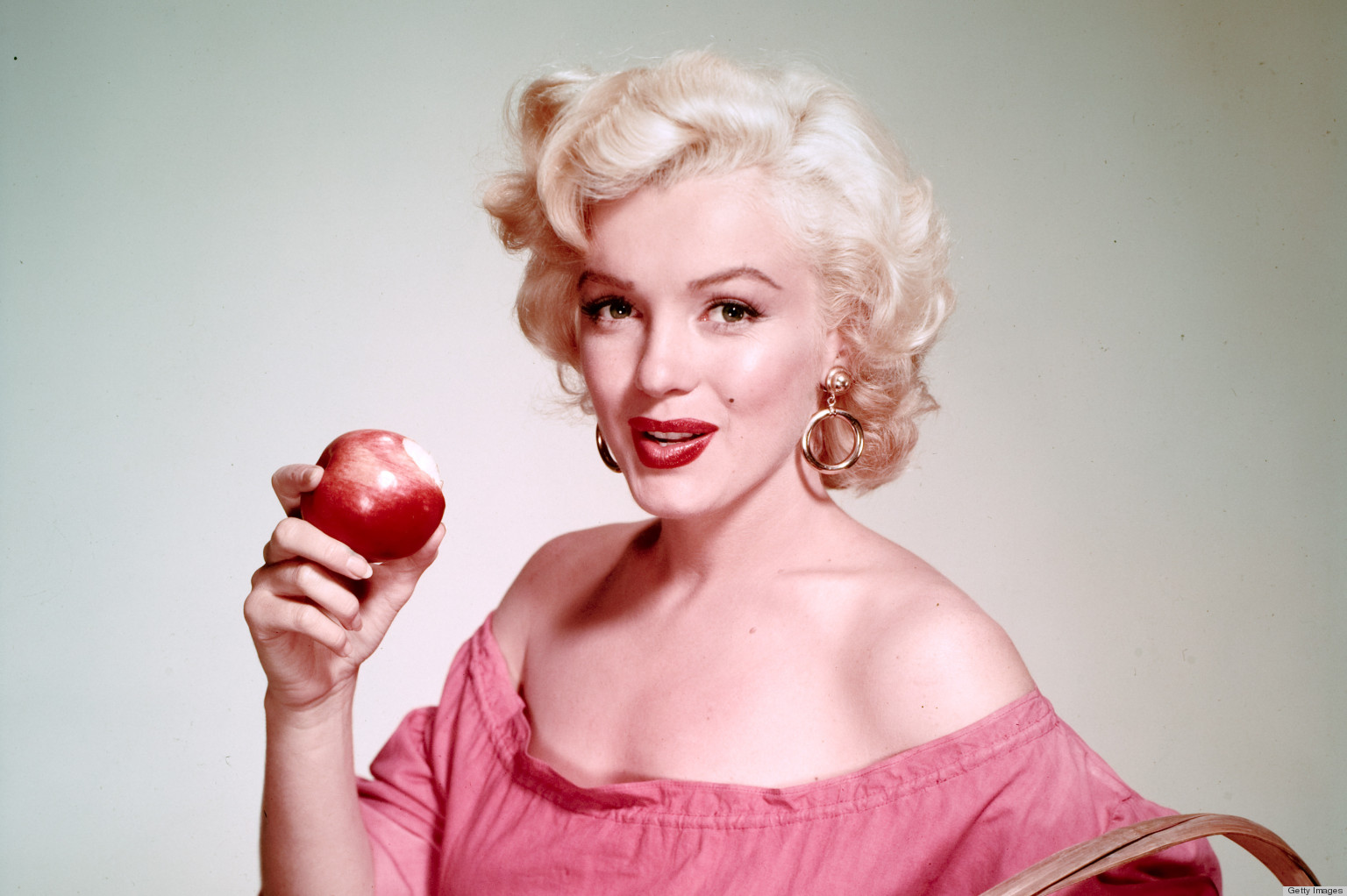
IN THIS ISSUE
LUCERNE
By John Mariani
NEW YORK CORNER
BENNO
By John Mariani
ITALIAN WINE'S GREATEST ADVOCATE,
LUCIO CAPUTO, PASSES AWAY
NOTES FROM THE WINE CELLAR
BROWN IS BEAUTIFUL
By John Mariani
❖❖❖
LUCERNE
By John Mariani
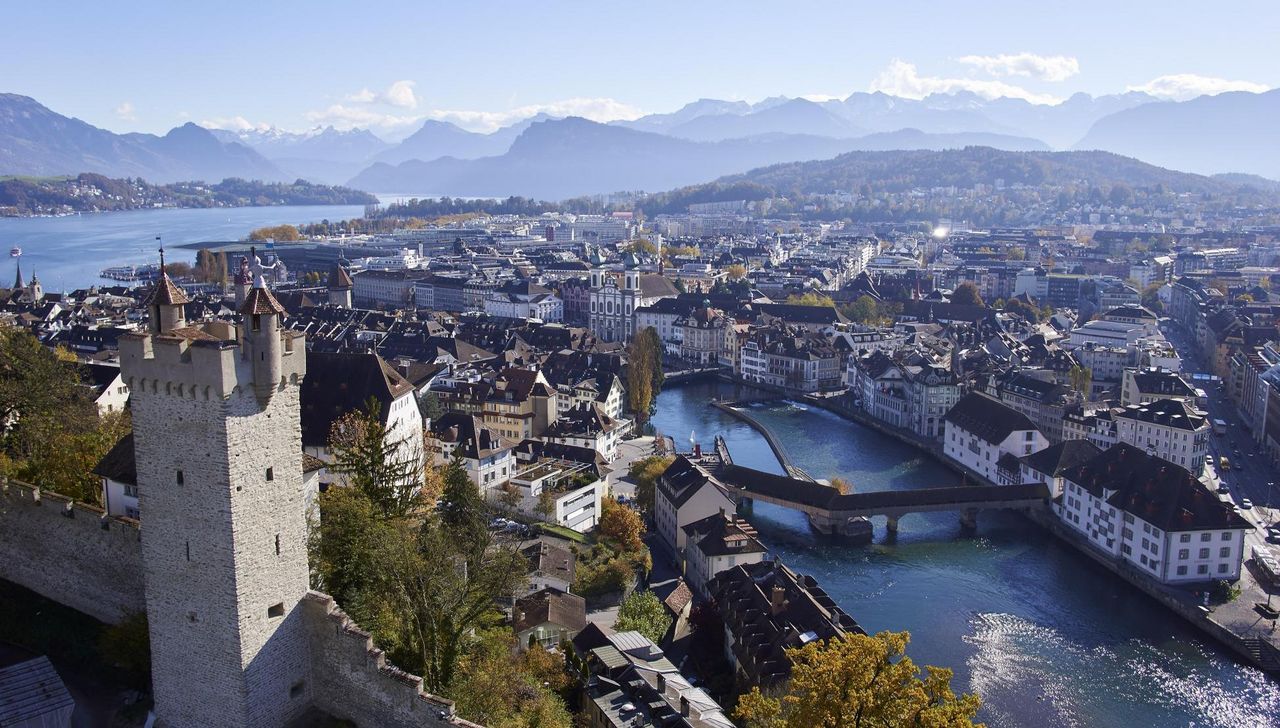
In
a country with an inordinate number of beautiful
cities and towns, Lucerne stands out even in
Switzerland.
Most of its allure is the sheer location
of the city within sight of the Alps and on the
banks of the crystal blue Lake Lucerne, which
appears to have been pushed into the cityscape
by a water god’s huge index finger. The
silver-white clouds seem meticulously painted in
each morning, then smeared into fiery orange and
deep violet at twilight.
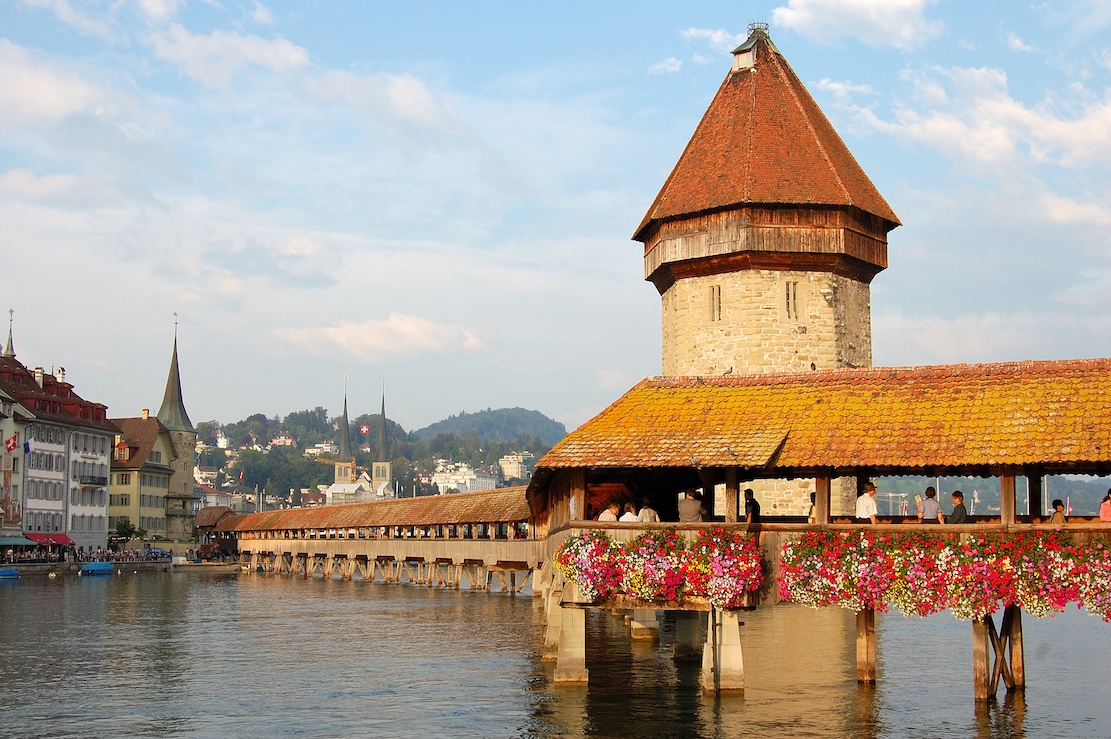 As the central Switzerland capital
of the German canton of Lucerne, it is a small
city, with only about 82,000 people, compared with
Lausanne’s 140,000 and Zurich’s 1.5 million
residents. For that reason, and because the local
government rigorously maintains the historic
appearance of a city whose buildings are painted
in a form of whimsical graffiti, Lucerne appears
largely immutable, not least the famous 14th
century wooden covered Chapel Bridge that spans
the River Reuss. Sadly damaged by a fire in 1993,
much of it had to be replaced and replicated, but
you can still see the 17th century painted scenes
in the supporting woodwork, which I trust are now
well protected from the ravages of time.
As the central Switzerland capital
of the German canton of Lucerne, it is a small
city, with only about 82,000 people, compared with
Lausanne’s 140,000 and Zurich’s 1.5 million
residents. For that reason, and because the local
government rigorously maintains the historic
appearance of a city whose buildings are painted
in a form of whimsical graffiti, Lucerne appears
largely immutable, not least the famous 14th
century wooden covered Chapel Bridge that spans
the River Reuss. Sadly damaged by a fire in 1993,
much of it had to be replaced and replicated, but
you can still see the 17th century painted scenes
in the supporting woodwork, which I trust are now
well protected from the ravages of time.
The Chapel Bridge (left) is
Lucerne’s most endearing landmark—with two others
downriver, the Spreuer Bridge and the
Mill Bridge—along with an adjacent watch tower,
but there is hardly a street or plaza that appears
when you curve past a church that does not hold
considerable architectural and artistic interest.
The city has been Catholic for
centuries, so in addition to the usual excess of
small churches, including the sober-sided Jesuit St.
Paul's (right),
whose interior is gussied up as of the 17th
century with an effusive baroque interior you
would never find in a Protestant church.
One of the city’s beloved
landmarks is the “Lion of Lucerne” monument by
Bertel Thorvaldsen, in memory of the Swiss guards
slain while defending the Tuileries
in Paris in 1792. There is a museum
devoted to Richard Wagner, who lived in Lucerne
for six years, which includes the Erard grand
piano on which Wagner completed “The
Mastersingers of Nuremberg” and other works.
The History Museum is devoted
to the artifacts of the cultural-historical and
folkloristic past of the canton, while the Glacier
Garden takes you all the way back to the last Ice
Age 20,000 years ago and beyond to a time 20 million years ago when
the area sprouted palm trees as a subtropical
ocean region.
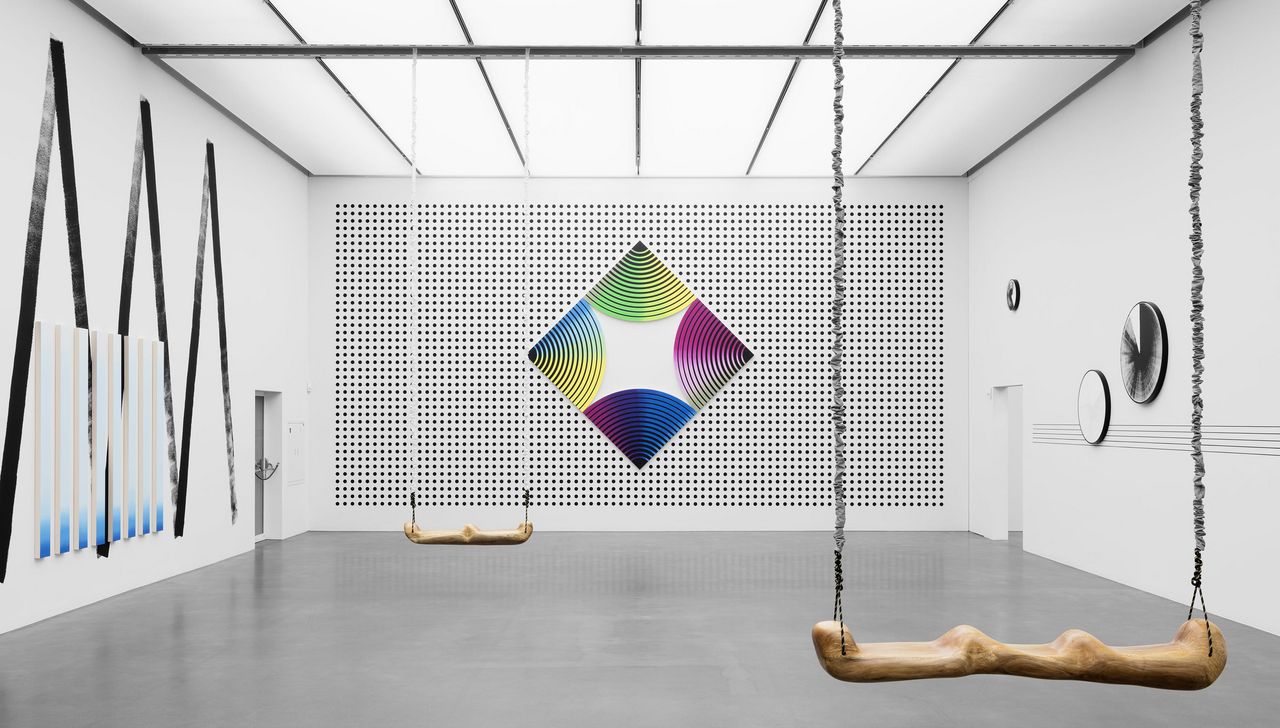 The
website for the Museum of Art Lucerne (left) poses
the question, “Do the
names Hodler or Vallotton mean anything to you?
These gentlemen are two of Switzerland’s
best-known artists [and] they and their artist
compatriots are the focus of the collection of
the Museum of Art Lucerne.” So be it, but the
very modern museum has a great deal more to
offer to those open to learning about Swiss art
from the Renaissance to the present day.
The
website for the Museum of Art Lucerne (left) poses
the question, “Do the
names Hodler or Vallotton mean anything to you?
These gentlemen are two of Switzerland’s
best-known artists [and] they and their artist
compatriots are the focus of the collection of
the Museum of Art Lucerne.” So be it, but the
very modern museum has a great deal more to
offer to those open to learning about Swiss art
from the Renaissance to the present day.
Usually the
idea of visiting a Museum of Transport (below) sends
me in the other direction, but I found myself
astounded by the richness of a collection sprawled
over acres and several floors, with 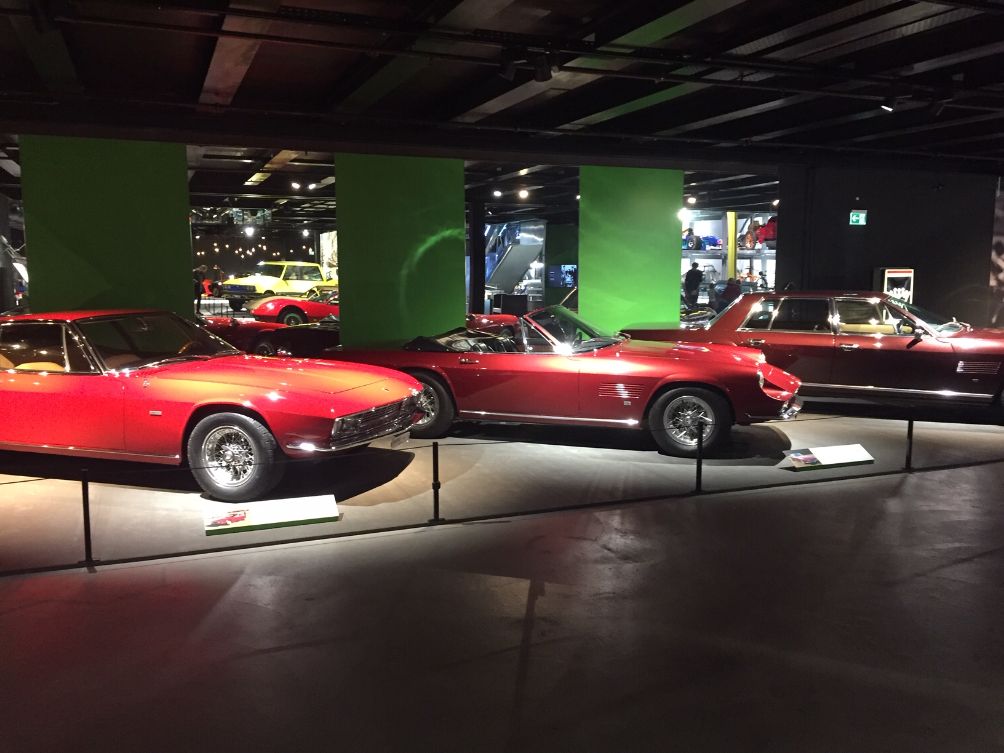 many
interactive features, that gives an in-depth
history of everything from the earliest river
boats and massive steam locomotives to horse drawn
carriages and a fantastic array of automobiles
that includes dozens of the finest Italian sports
cars. Inside there are flight simulators, exhibits
of space exploration and aviation movies, and
outside a number
of historic airplanes. There is also Switzerland’s largest cinema
screen showing 3-D documentaries on the
achievements by man in the field of transportation
that have taken us to the moon and back. It is not
a museum to be missed.
many
interactive features, that gives an in-depth
history of everything from the earliest river
boats and massive steam locomotives to horse drawn
carriages and a fantastic array of automobiles
that includes dozens of the finest Italian sports
cars. Inside there are flight simulators, exhibits
of space exploration and aviation movies, and
outside a number
of historic airplanes. There is also Switzerland’s largest cinema
screen showing 3-D documentaries on the
achievements by man in the field of transportation
that have taken us to the moon and back. It is not
a museum to be missed.
As everywhere in Switzerland,
the arts count heavily in a civilized society, and
Lucerne holds arts festivals throughout the year,
including summer’s Lucerne Festival for
classical music whose musicians are chosen from
around the world to join the city’s Festival
Orchestra. In June the “B-Sides” pop music
festival takes place, showcasing alternative music
and indie rock; the following month brings in
The Lucerne Blues Festival.
The best way to get around and
to visit these attractions is with The Visitor Card,
which gives you free use of buses and trains
within the city,
as well as a range of discounts for
cableways, mountain railways, museums and
excursions in the Lake Lucerne Region.
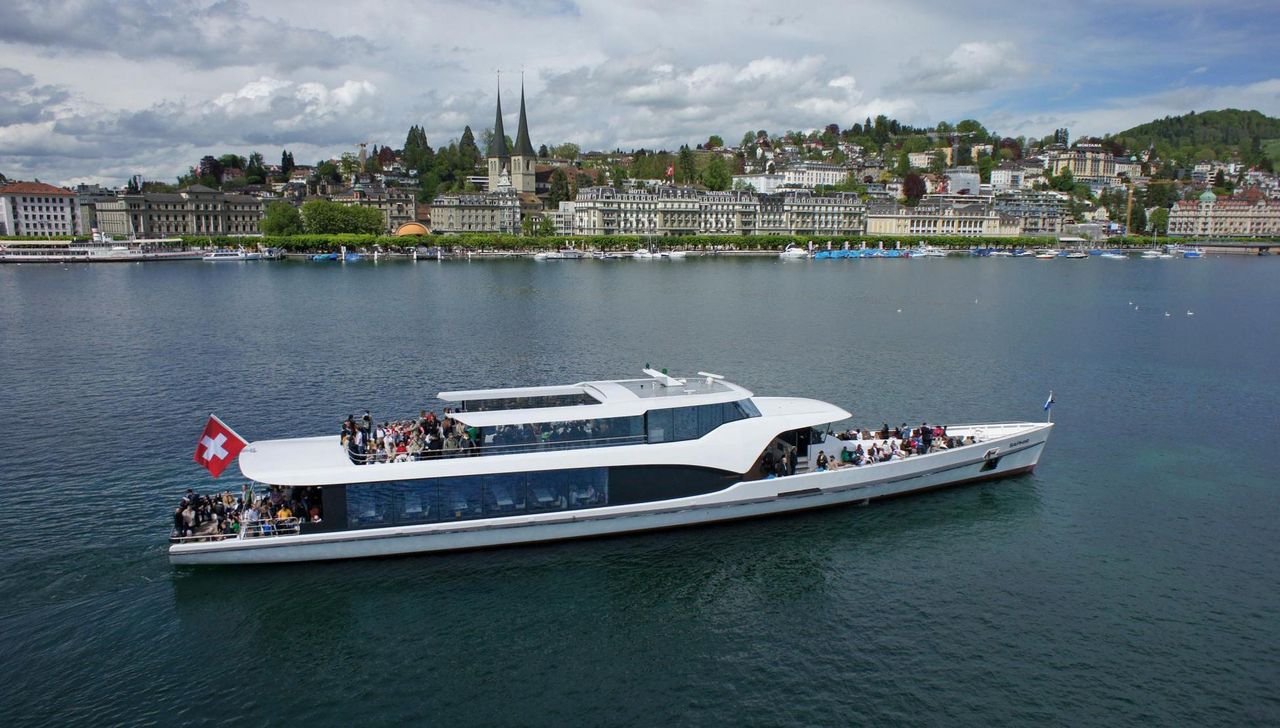 As
remarkable and varied as these cultural
attractions are, however, if you removed them all
from Lucerne, you’d still have a city whose
principal appeal will be along the waterfront
promenade and throughout the streets and plazas in
the old part of town. You can take a one-hour
yacht cruise (left)
on Lake Lucerne (there’s an audio guide in 11
languages) and a boat across the lake and a tram
up to the magnificent Bürgenstock Resort (which I
shall be writing about soon).
As
remarkable and varied as these cultural
attractions are, however, if you removed them all
from Lucerne, you’d still have a city whose
principal appeal will be along the waterfront
promenade and throughout the streets and plazas in
the old part of town. You can take a one-hour
yacht cruise (left)
on Lake Lucerne (there’s an audio guide in 11
languages) and a boat across the lake and a tram
up to the magnificent Bürgenstock Resort (which I
shall be writing about soon).
Zigzagging across the Reuss
River on Lucerne’s three bridges brings you to
different neighborhoods, each with its own compact
charms. Streets might be broad or narrow, but
their connecting passageways and few grids always
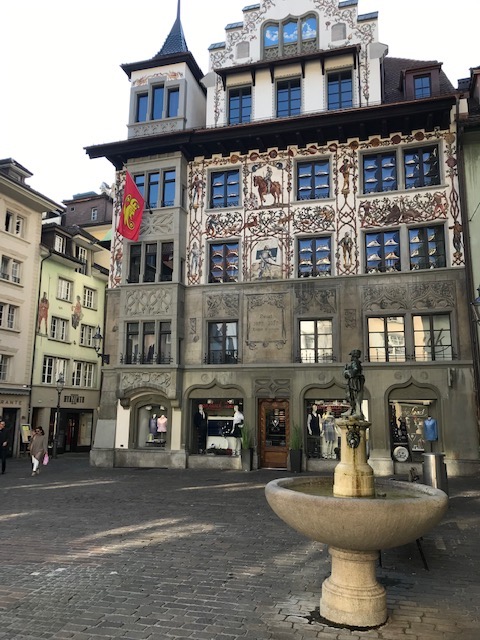 make the next turn a
surprise. You may find a block of buildings with
their facades gaily painted, including the Old
Town Hall overlooking the Kornmarkt, built early
in the 17th century. To the left there is a
building called the Am Ryhn House in which the
Rosengart Collection shows its Picasso holdings.
Nearby is Stag Square, where Goethe stayed and
wrote at the Goldener Adler hotel, though now very
modern and without a trace of 19th century décor.
There is a Wine Market with very pretty buildings,
and outdoor food markets are held with weekly
regularity.
make the next turn a
surprise. You may find a block of buildings with
their facades gaily painted, including the Old
Town Hall overlooking the Kornmarkt, built early
in the 17th century. To the left there is a
building called the Am Ryhn House in which the
Rosengart Collection shows its Picasso holdings.
Nearby is Stag Square, where Goethe stayed and
wrote at the Goldener Adler hotel, though now very
modern and without a trace of 19th century décor.
There is a Wine Market with very pretty buildings,
and outdoor food markets are held with weekly
regularity.
Everyone
walks in Lucerne—I never saw a taxi or Uber
car—and that makes it a marvelously quiet city,
day and night. You have to listen carefully to
hear the babble of the water break on the Reuss
that quickens the flow from the widest part of the
river. It’s the kind of gentle, calming rippling
well worth remembering long after you’ve left
Lucerne, when you find it hard to fall asleep.
❖❖❖
By John Mariani
BENNO NYC
The
Evelyn Hotel
7 East 27th Street (near
Madison Avenue)
212-451-9557
Photos: Evan Sung
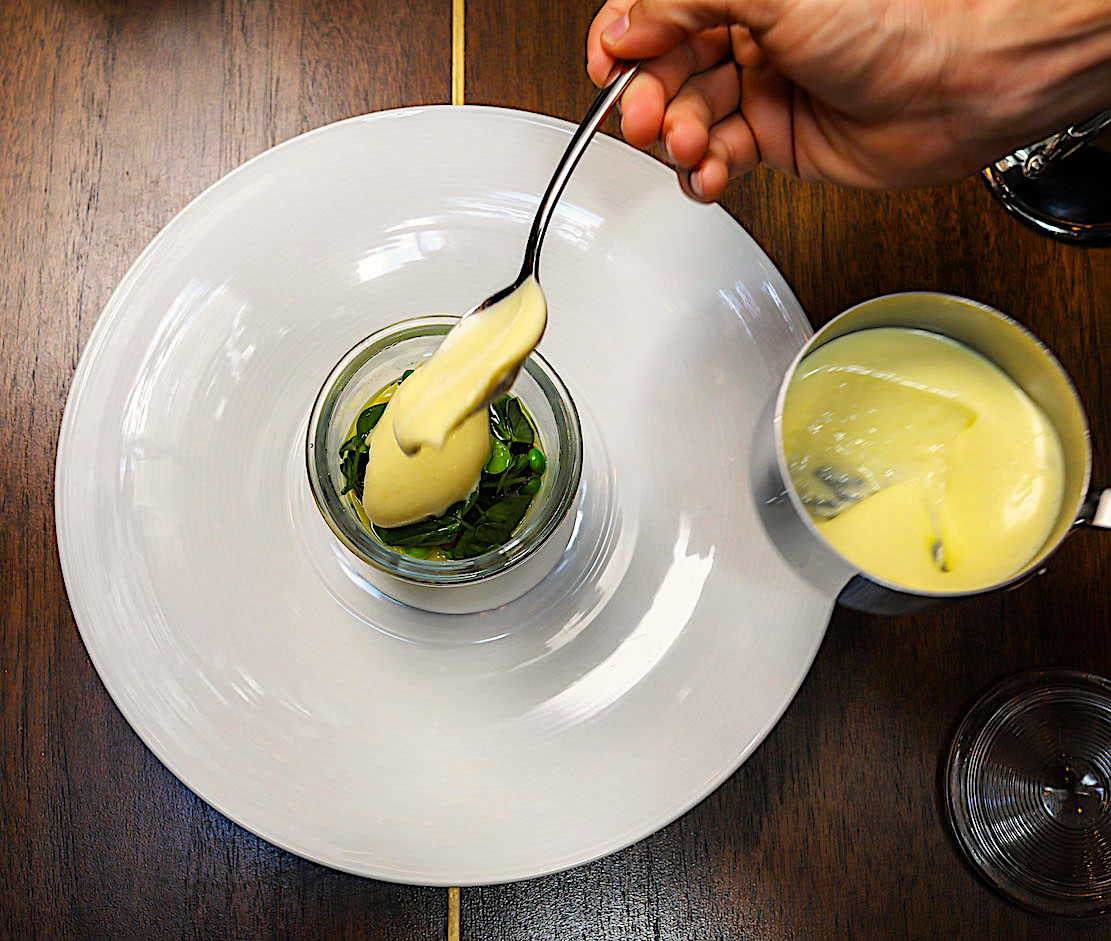
At a time when
the New York food media go giddy over ramen
shops, tacquerias and pizzerias, there are
certain high-end restaurant openings that cannot
be ignored, especially if the chef has the name
recognition of Jonathan Benno, first as chef de
cuisine at Thomas Keller’s Per Se, then as
executive chef at 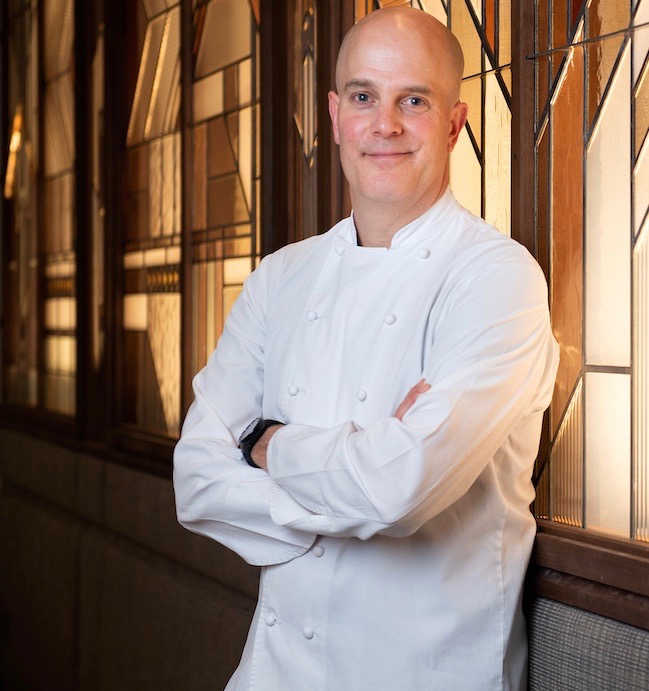 Lincoln
Ristorante at Lincoln Center. At both places,
refinement was the order of the day, along with
an attention to precision, color and invention
without pretension. So his appearance at a
restaurant in The Evelyn Hotel with his name on
the door made it requisite for the New York
media to pay court. He won three stars from the
Times.
Lincoln
Ristorante at Lincoln Center. At both places,
refinement was the order of the day, along with
an attention to precision, color and invention
without pretension. So his appearance at a
restaurant in The Evelyn Hotel with his name on
the door made it requisite for the New York
media to pay court. He won three stars from the
Times.
At the hotel Benno runs three
places—a casual trattoria named Leonelli Taberna,
a bakery named Leonelli Focacceria &
Pasticcieria, and his fine dining spot and bar,
Benno. It’s a big operation within small spaces,
the last up a few steps and through a separate
doorway. The greeting by Manager Andrea Verardo
will be affably cordial, as is the staff. The chef
de cuisine is Justin Skribner.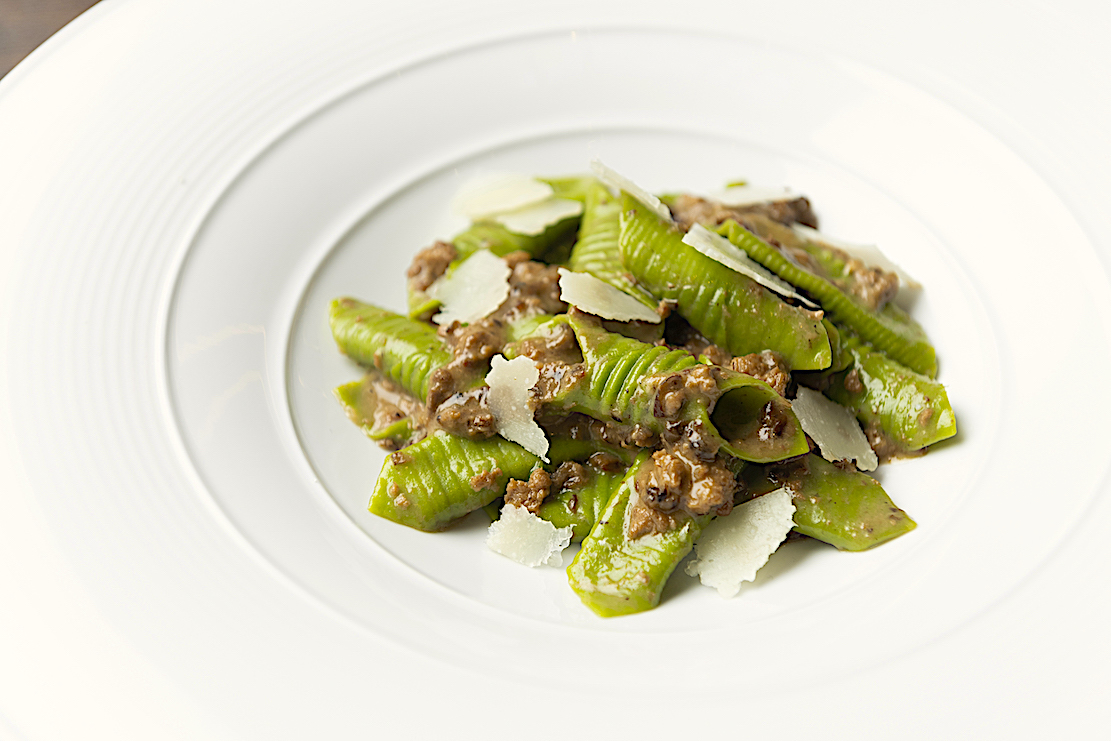
At Lincoln Ristorante Benno’s
menu was dedicated to modern Italian cuisine, but
here he is drawing on classic and modern
Mediterranean and French concepts as well, all
based on the finest ingredients he can obtain,
whether from Montauk or Monterey Bay. There are five
sections to the menu—
Vegetables & Grains, Seafood & Meat,
Pastas, Mains and Desserts—available at
three- ($105), four- ($135) or five-course ($155)
options, with added wine pairings available. You
may choose from any of the categories in whatever
order you wish.
Dinner
begins with filaments of grissini breadsticks
while you peruse wine director Aaron Rock’s
20-page wine list, rich in Nebbiolos, Brunellos
and Bordeaux, with 20 labels from the 2005
vintage. Rock is as knowledgeable as he is
passionate and will guide you to the right wine in
your price range.
Among the starters, a coddled
egg sounds a little dull until you taste Benno’s
with buttery fingerling potatoes, young leeks, porcini
mushrooms and a lush black truffle mousseline. So,
too, the addition of mustard seed and marigold
adds to the flavor and texture of a fluke crudo,
whereas the yellowfin tuna is of such superb
quality that the accompanying cucumbers and radish
register only subtly. A salad of roasted beets is
really an amalgam of sunchokes, amaranth,
radishes, pomegranate, garnet yam and vadouvan
yogurt.
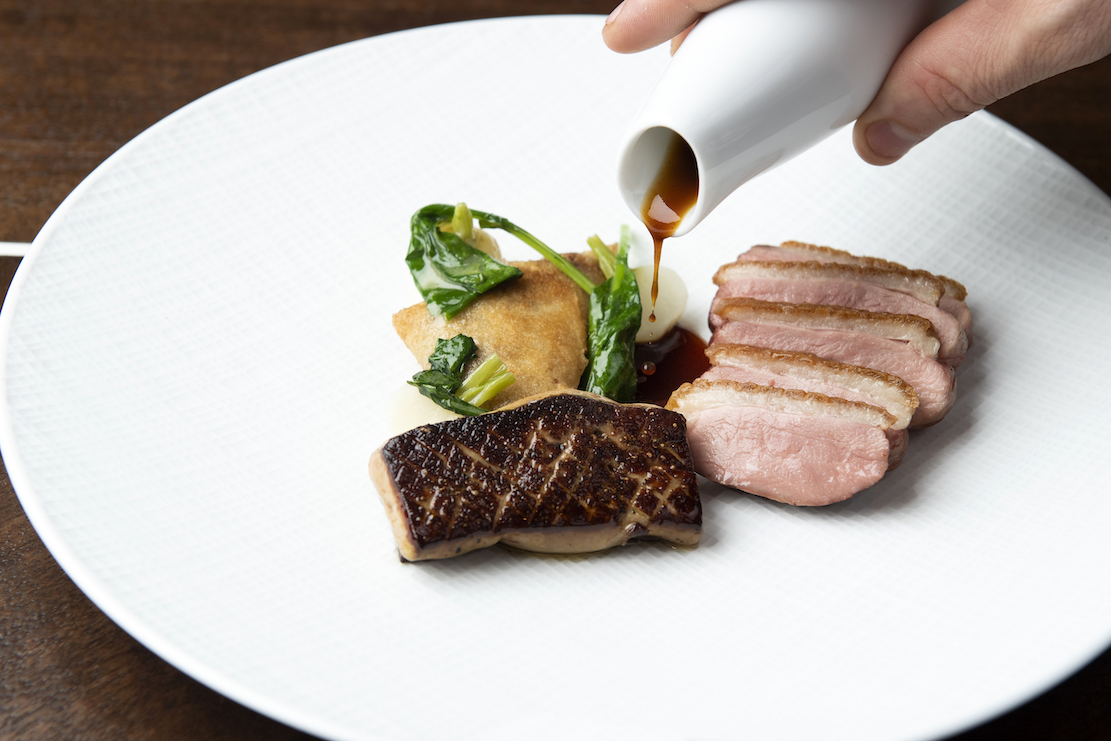 The pastas
could be the star items on the menu, from a
risotto with celery root, red walnut, black
truffle and castelrosso cheese, and cansoncelli
ravioli from Veneto with roasted
artichokes, black truffle, brown butter and
pecorino romano, to garganelli
verdi with a rich veal and porcini
ragù and a spaghetti of the roasted grain
called gran
arso tossed with clams, sea urchin and
scallion.
A large raviolo
comes with vegetables, ricotta and brown butter,
while Sardinian malloreddus
is in a hefty sauce of braised lamb, tomatoes,
capers and oregano. Agnolotti
del plin, a kind of Piedmontese ravioli,
is stuffed with duck foie gras and juniper for
its aromatic character.
The pastas
could be the star items on the menu, from a
risotto with celery root, red walnut, black
truffle and castelrosso cheese, and cansoncelli
ravioli from Veneto with roasted
artichokes, black truffle, brown butter and
pecorino romano, to garganelli
verdi with a rich veal and porcini
ragù and a spaghetti of the roasted grain
called gran
arso tossed with clams, sea urchin and
scallion.
A large raviolo
comes with vegetables, ricotta and brown butter,
while Sardinian malloreddus
is in a hefty sauce of braised lamb, tomatoes,
capers and oregano. Agnolotti
del plin, a kind of Piedmontese ravioli,
is stuffed with duck foie gras and juniper for
its aromatic character.
But
there’s every bit as much flair and innovation in
the main courses, starting with yellowfin tuna
with fingerlings, a confit 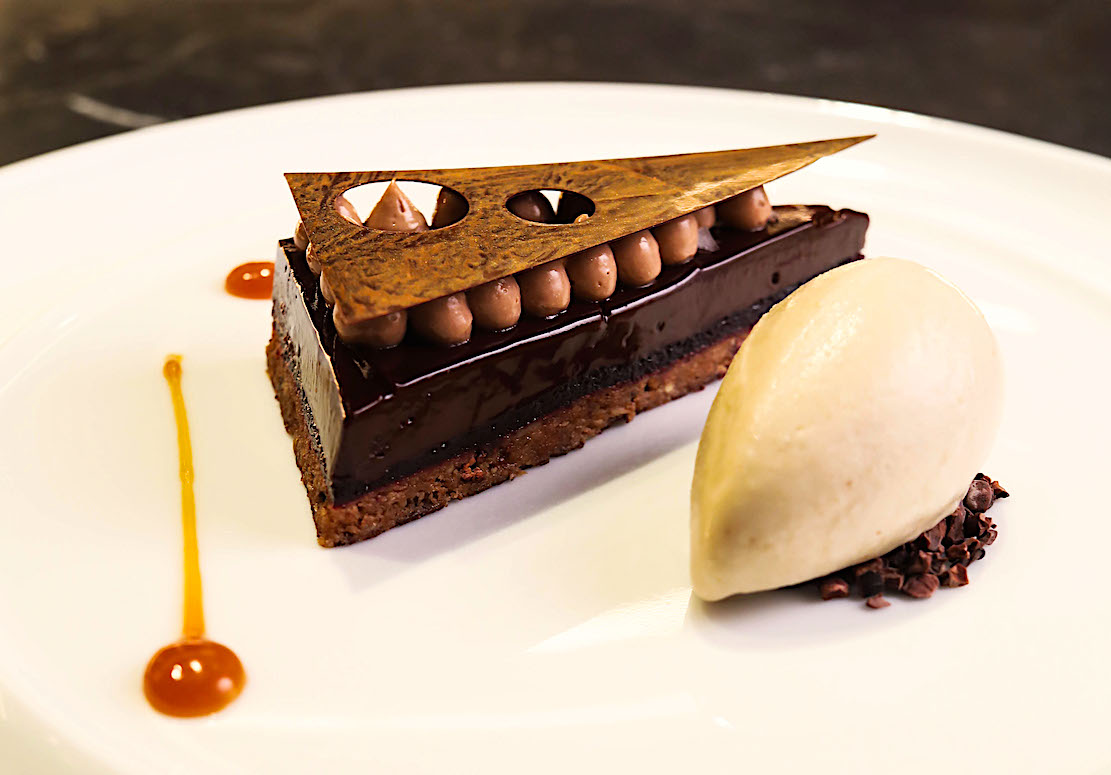 of tomatoes, picholine
olives and a pistou,
along with lobster with peas, carrots,
chanterelles and mustard sauce. Skate,
too rarely seen on menus, shows its mettle with
sliced almonds, butter and a lovely, light peeky
toe crab mousse and acorn squash. Another
neglected species, sea trout, is poached carefully
in olive oil to become lustrous, with Moroccan
olives, butter endive, sweet currants,
pink-fleshed cara cara
orange and grapeseed-based arak liquor—not just an
imaginative dish but the makings of a classic to
come.
of tomatoes, picholine
olives and a pistou,
along with lobster with peas, carrots,
chanterelles and mustard sauce. Skate,
too rarely seen on menus, shows its mettle with
sliced almonds, butter and a lovely, light peeky
toe crab mousse and acorn squash. Another
neglected species, sea trout, is poached carefully
in olive oil to become lustrous, with Moroccan
olives, butter endive, sweet currants,
pink-fleshed cara cara
orange and grapeseed-based arak liquor—not just an
imaginative dish but the makings of a classic to
come.
Pig’s trotter is made into a
garlicky sausage, served with beans and quail
eggs, and Benno uses a Long Island Pekin duck to
combine with foie gras, a complex mix of North
African seasonings called ras el hanout,
turnips and a 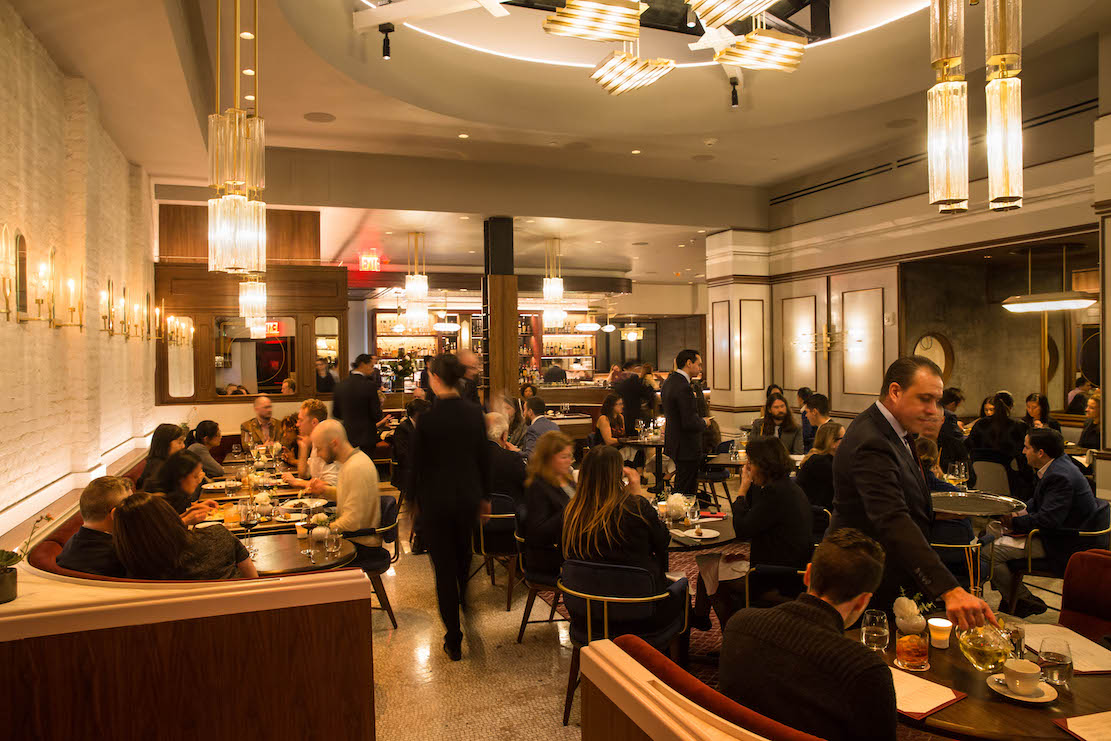 pistachio-date
brik
pastry, perhaps the heartiest item on a menu that
ranges far and wide around the Mediterranean.
pistachio-date
brik
pastry, perhaps the heartiest item on a menu that
ranges far and wide around the Mediterranean.
Desserts by Lindsey Bittner are
deceptively simple, though never simplistic, like
apple sorbet with dates, pears with goat’s cheese
and saffron, almonds and pear brandy sorbet. There
is also a selection of cheeses available.
This splendid cuisine and wine
deserve an equally refined dining room, but sadly
it is done all in browns and beige, with off-white
rough brick walls, blue and maroon chairs and
banquettes, the tables uncovered, the lighting
flat, the tiled floor without visual interest.
Tablecloths and a few gallons of paint might help
to brighten the place, but for now, the décor does
not match Benno’s cuisine.
Still,
by diverting slightly from the Italian food he
prepared at Lincoln Ristorante and the overly
detailed food at Per Se, Benno has come wholly
into his own and sets a standard for New York
chefs everyone else should try hard to meet.
Benno is open for dinner, Tues-Sat.
LUCIO CAPUTO, PASSES AWAY
By John Mariani
All
those who love Italian wine, style and culture
have lost one of the most influential advocates.
Dr. Lucio Caputo, founder and president of the
Italian Wine & Food Institute, a non-profit
organization established in 1983 to promote and
improve the image of Italian wine and food in
the United States, passed away last week at the
age of 84, after succumbing at
last to cancer, having survived it twice
before.
 Caputo was the epitome of the tall,
handsome, impeccably dressed Italian gentleman,
with a sly wit that belied his serious
professional demeanor. As a promoter of Italian
wine, fashion and textiles, no one did more for
those industries in so short a time.
Caputo was the epitome of the tall,
handsome, impeccably dressed Italian gentleman,
with a sly wit that belied his serious
professional demeanor. As a promoter of Italian
wine, fashion and textiles, no one did more for
those industries in so short a time.
Born in Monreale, Sicily, Caputo
received a doctorate in law, a degree in
journalism and a doctorate in political science
from the University of Palermo. He served as a
correspondent then editor of the Giornale di
Sicilia, one of Italy’s major daily
newspapers, completed courses in public relations
and was admitted to the bar and began a legal
career with a major law firm.
After completing his tour of
service as a lieutenant in the Italian Air Force,
Caputo joined Italy’s Foreign Trade Institute in
Rome, and in 1964
was appointed deputy director of the
Institute’s London office, traveling extensively
throughout Europe, Africa and Asia, where he was
able to defuse a dangerous trade war between Italy
and the People’s Republic of China.
Appointed Italian Trade
Commissioner in New York in October 1967, he
opened the new office in the World Trade Center,
then in 1981 moved it uptown to Park Avenue, where
it became the largest trade center of any foreign
country in the United States, with a stunning enoteca wine
library designed by the architect Piero Sartoro
—complete with a Giorgio di Chirico painting, “Le Muse
Inquietanti” (below)— that served as an
invaluable resource for Italian winemakers and
exporters for showing their products to an
American wine media that at the time had little
knowledge beyond the few imports of Chianti,
Valpolicella and Soave then dominating the market.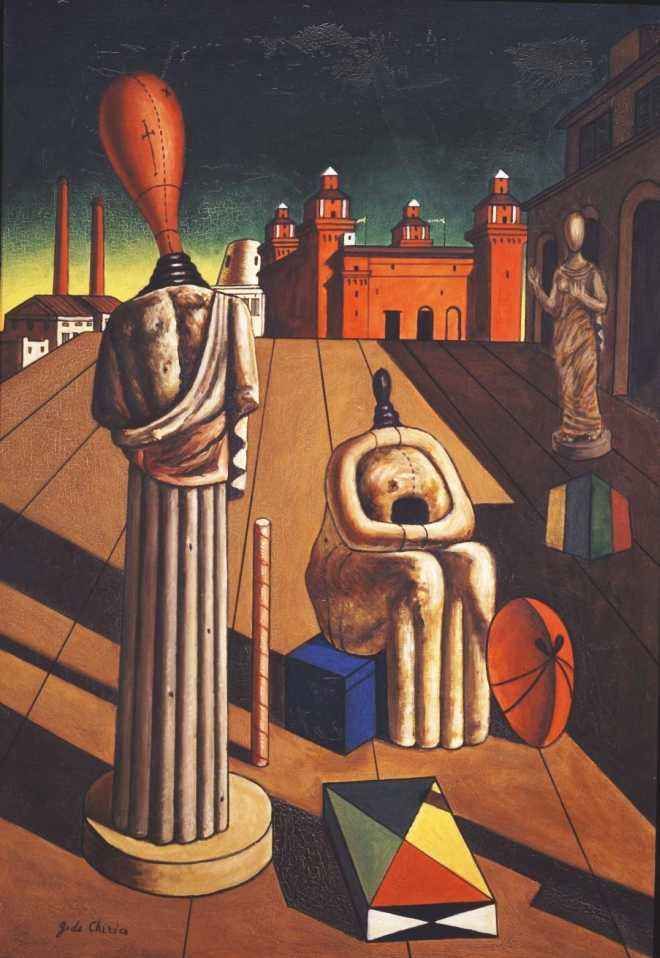
At the same time Caputo also promoted
Italian fashion and textiles, but wine was his
passion, and by inviting wine journalists to Italy
on press trips he exposed them to the enormous
variety of his country’s wines when Italian
viticulture had taken leaps in quality and
consistency, championed by a new generation of
vintners who included Angelo Gaja of Piedmont,
Marchesi Piero Antinori of Tuscany and
Mastroberardino of Campania.
Owing to his efforts, Italian
wines came to dominate the U.S. market for imported
wine, bringing it from the insignificant presence
of about 360,000
hectoliters for a value of about $37
million in 1974 to the dominant position of 2.5
million hectoliters for a value of $244 million in
1983.
In 1982 Caputo left his
government position and moved to the private
sector as president of Ital Trade USA corporation. The
next year he founded the Italian Wine & Food
Institute, a non-profit organization for the
enhancement of the image and prestige of Italian
wines, gastronomy and food products in the U.S.,
and in 1985 started the “Gala Italia,” a
star-studded, headline-winning event that brought
together some of the most illustrious names in
Italian wine, food, fashion and entertainment. It
has been held annually ever since.
In 1984 Caputo left the Ital
Trade USA corporation to become president of the
International Trade Center, specializing in
international promotional activities and public
relations and in consulting services to large
corporations based in New York and operating
worldwide. He also became the U.S. representative
of the “Ente Autonomo Fiere di Verona,” promoting
the Fair’s wine, marble and furniture trade
exhibitions to the U.S. and Canada and bringing
American delegations to Verona to participate in
these exhibitions.
For years, he organized Italian
promotional campaigns in department stores
throughout the world, including Bloomingdales,
Saks Fifth Avenue, The KaDeWe Group and Harvey
Nichols.
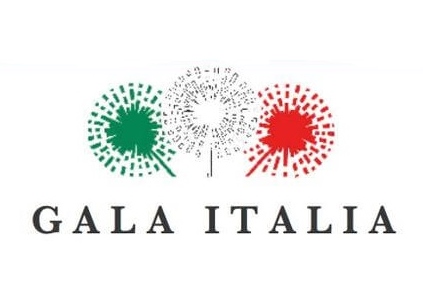 On the
morning of 9/11, Caputo was inside his office on
the 78th floor of the north tower of the World
Trade Center when the first plane hit the
building, escaping with his life but losing his
office and all of his working records. He
immediately relocated to Midtown Manhattan and was
up and running soon afterwards.
On the
morning of 9/11, Caputo was inside his office on
the 78th floor of the north tower of the World
Trade Center when the first plane hit the
building, escaping with his life but losing his
office and all of his working records. He
immediately relocated to Midtown Manhattan and was
up and running soon afterwards.
In recognition of his
outstanding work in favor of Italy, the president
of the Italian Republic awarded Caputo the title
“Cavaliere Ufficiale” in 1972,
“Commendatore” in 1981, “Grande Ufficiale” in 1996
and “Cavaliere di Gran Croce”—the highest
decoration in the Order of Merit of the Italian
Republic.
He was a tough negotiator and
could afford to be one. Whenever Italy balked at
increasing his budgets at the New York Trade
Commission, Caputo would shrug and say he’d quit. Given
the extraordinary success Caputo had in promoting
Italian products, the bureaucrats couldn’t say no.
He was worth every penny they paid for his
services.
Yet
such sterling achievements and such professional
honors do little to assess Caputo’s personality,
one I came to know more than 40 years ago when he
invited me on one of those press tours of Italian
vineyards. We quickly became fast friends, and,
while his English curiously never improved much
over those decades, he became the most American of
Italians, once telling me he had no desire to work
again in Italy because of the dreary inefficiency
of its bureaucracy.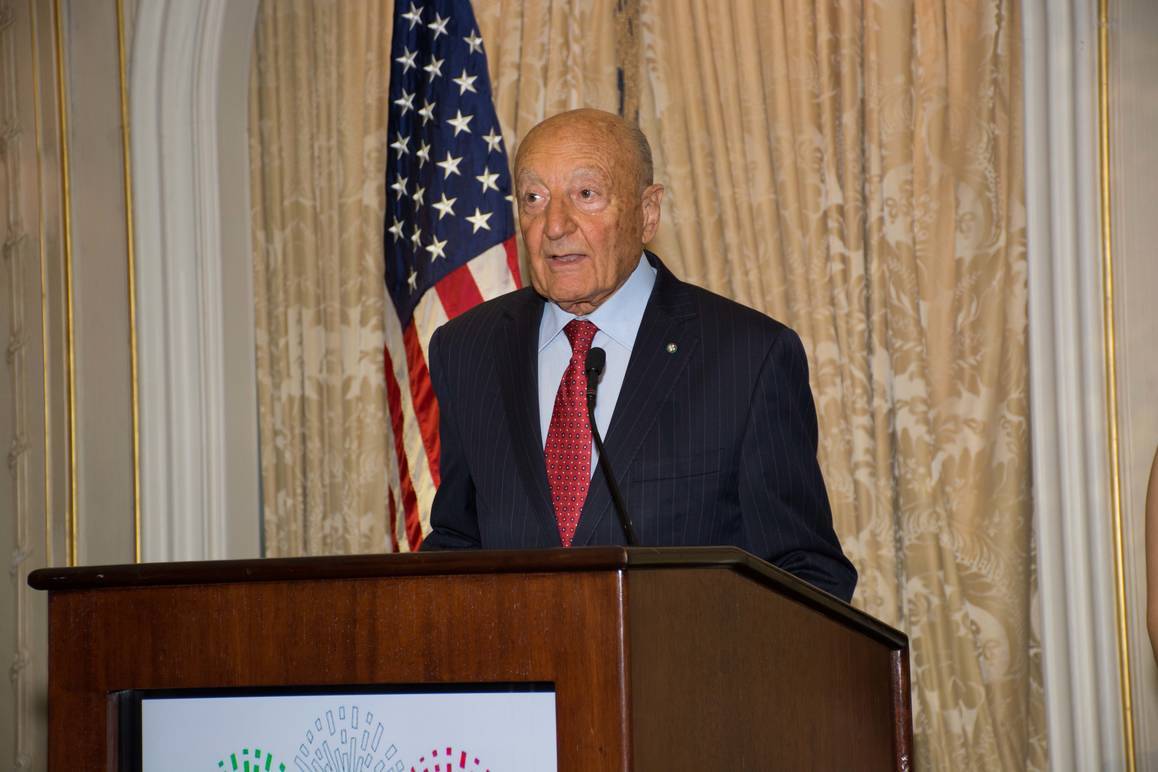
His sense of humor among
friends and colleagues was every bit as effective
as his lawyerly skills in persuading you to agree
with his side of a dispute, and his refinement—he
always kissed a woman’s hand upon greeting her—and
gentility were as genuine as his intellect.
I remember him once, back in
the early 1980s, inviting a group of Sicilian
winemakers to New York to meet American wine media
for a tasting. Shockingly, most of the wines were
oxidized, but afterwards the Sicilians complained
that they had always made their wines that way and
that the Americans simply could not appreciate
them. Upon hearing such ignorant boasting,
Caputo—in Sicilian dialect—told them, “Go out and
buy a good bottle of Bordeaux or Burgundy and
taste what wine is supposed to be. If you ever
want to sell your wines in America, you have to
change your attitude immediately.”
That was pure Caputo: direct,
informative and insistent that his highly
conservative compatriots get the point as quickly
as possible. What happened within the next decade,
of course, is that Sicilian winemakers took his
advice and today produce high quality wines all
over the island.
There
is an old Sicilian proverb that goes, “Cu nesci
arrinesci”—who leaves succeeds—which for me
sums up the character of Lucio Caputo, who left
behind what was safe and secure to tell the world
how wonderful it was.
By John Mariani
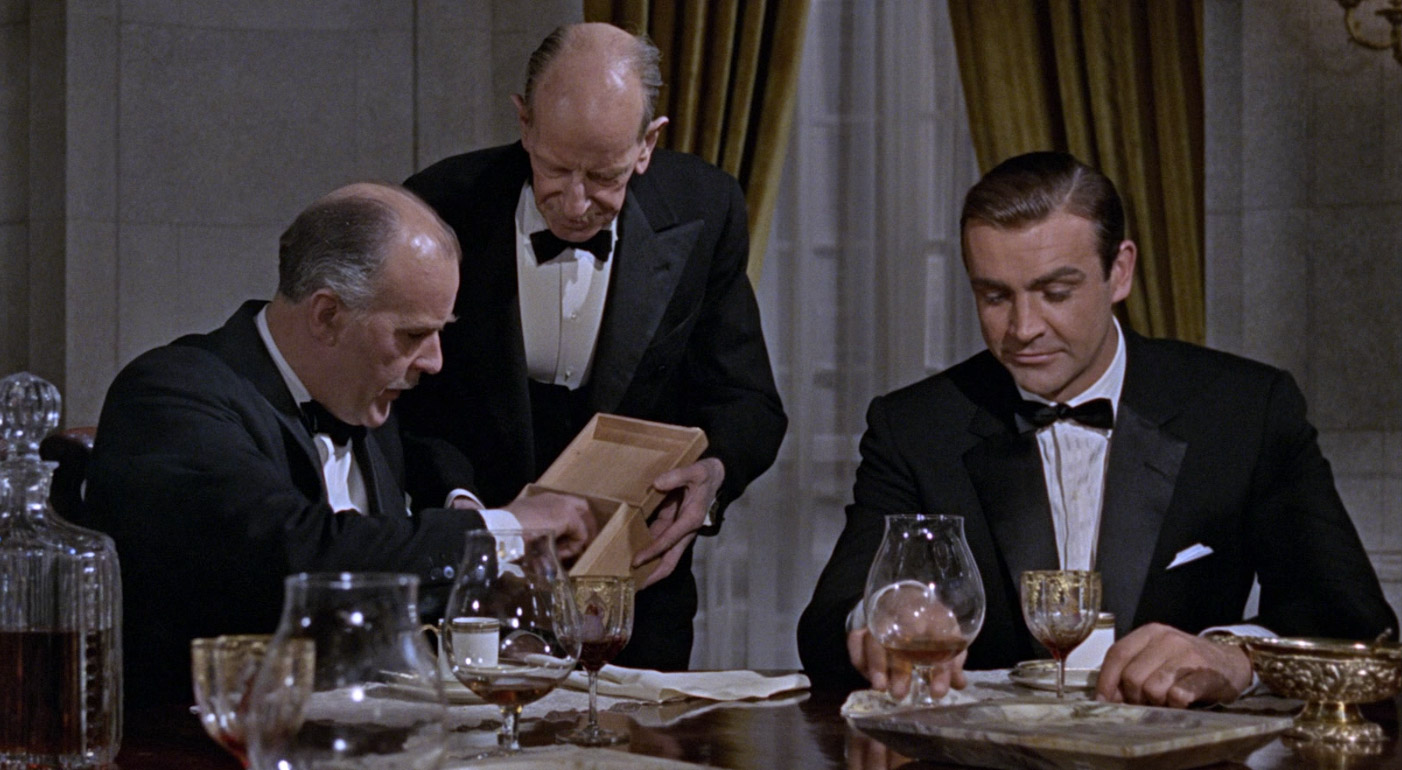
Richard Vernon and Sean Connery in "Goldfinger" (1964)
The
newly appointed editor-in-chief of Esquire
magazine, Michael Sebastian, recently told
the press that he wants to get away from the
idea that the magazine’s reader is “a
middle-age white guy who likes brown liquor
and brown leather.” Which
should send chills down the ad department’s
spine working on those Scotch and bourbon
accounts!
True, Millennials may drink
more vodka—which the U.S. Standards of
Identity defines as “neutral spirits so
distilled, or so treated 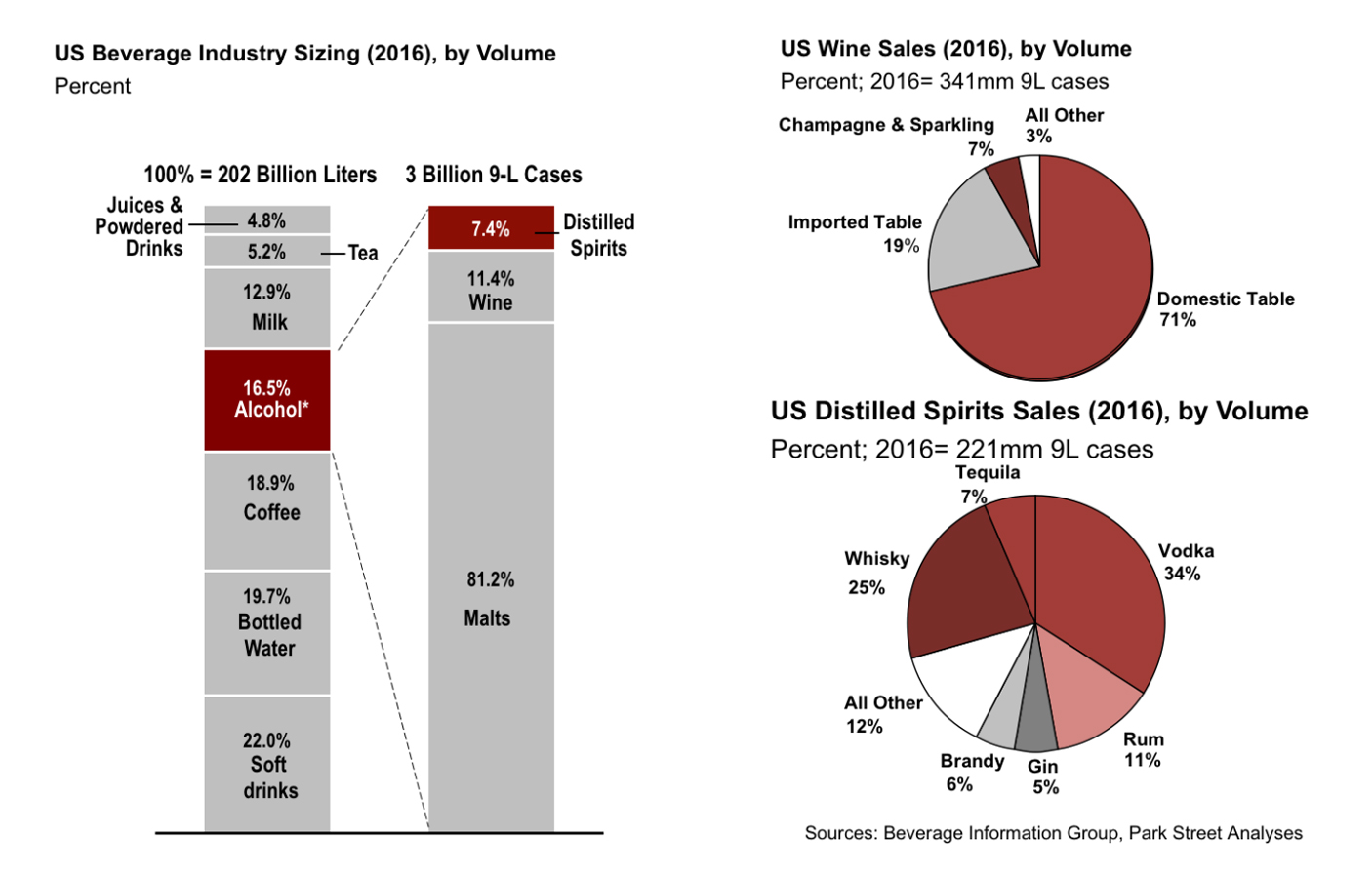 after
distillation with charcoal or other materials,
as to be without distinctive character, aroma,
taste, or color”—but overall, whiskey is
second and rum third (though white rums
dominate that category) in total volume and
sales. (I have no figures for the sales of
brown leather.)
after
distillation with charcoal or other materials,
as to be without distinctive character, aroma,
taste, or color”—but overall, whiskey is
second and rum third (though white rums
dominate that category) in total volume and
sales. (I have no figures for the sales of
brown leather.)
Brown spirits are doing
very well indeed. According to The Distilled
Spirits Council, 2018 marked the ninth
straight year of record spirits sales and
volumes, at $27.5 billion, up 5 million cases
from the prior year, with higher priced
“premium” and “ultra-premium” spirits growing
faster than the overall industry. According to
the council’s chief economist, David Ozgo, the
key drivers were American whiskey, up 6.6
percent;
tequila, up 10.2 percent; Cognac, up
14.2 percent; Irish whiskey, up 12.0 percent;
and single malt Scotch, up 9.4 percent.
Which leaves me to consider
some current releases in the brown spirits
category. Spirits companies are constantly
coming out with new products to engage both
the confirmed drinkers and to attract
newcomers. Sometimes this means little more
than the same old booze in a brand new bottle,
or the alleged discovery of some very old
demi-johns sitting up in a warehouse attic—of
which there seems to be a near-endless supply
if there’s a market for it.
Here
are some of the more interesting whiskies and
other brown spirits I’m enjoying this summer
and will well into fall.
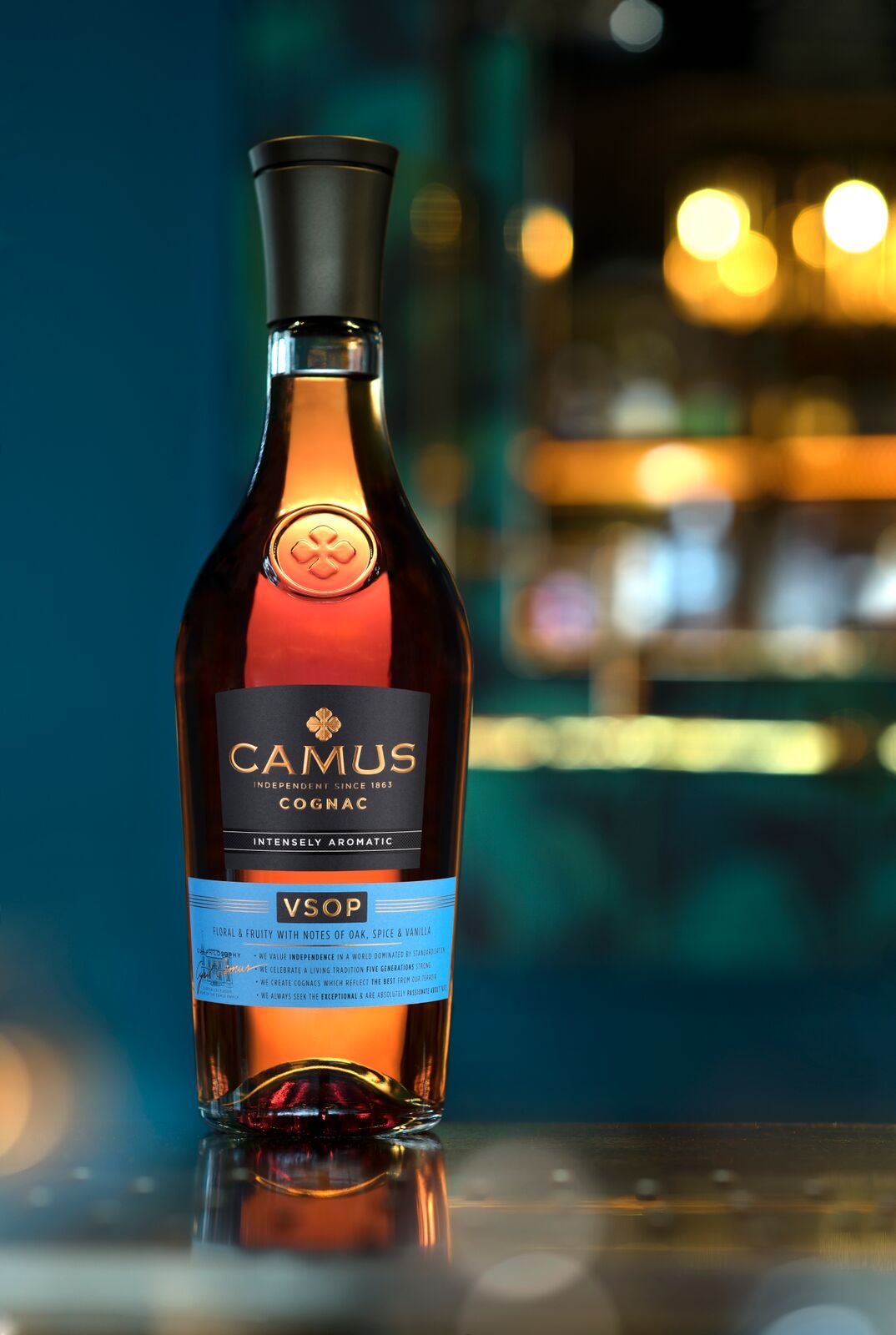 CAMUS VSOP
COGNAC ($49.99)—Five
generations of the Camus family, dating to
1863, have locked in the brand’s reputation.
The current scion, Cyril Camus, has broadened
his brand through Chinese distribution.
Located in the Borderies cru area, which
comprises only five percent of the region’s
AOCs, Camus uses eaux-de-vie from that region
as well as from the other five Cognac crus.
The VSOP has even more individuality and
character, particularly in its aromatic and
fruit notes.
CAMUS VSOP
COGNAC ($49.99)—Five
generations of the Camus family, dating to
1863, have locked in the brand’s reputation.
The current scion, Cyril Camus, has broadened
his brand through Chinese distribution.
Located in the Borderies cru area, which
comprises only five percent of the region’s
AOCs, Camus uses eaux-de-vie from that region
as well as from the other five Cognac crus.
The VSOP has even more individuality and
character, particularly in its aromatic and
fruit notes.
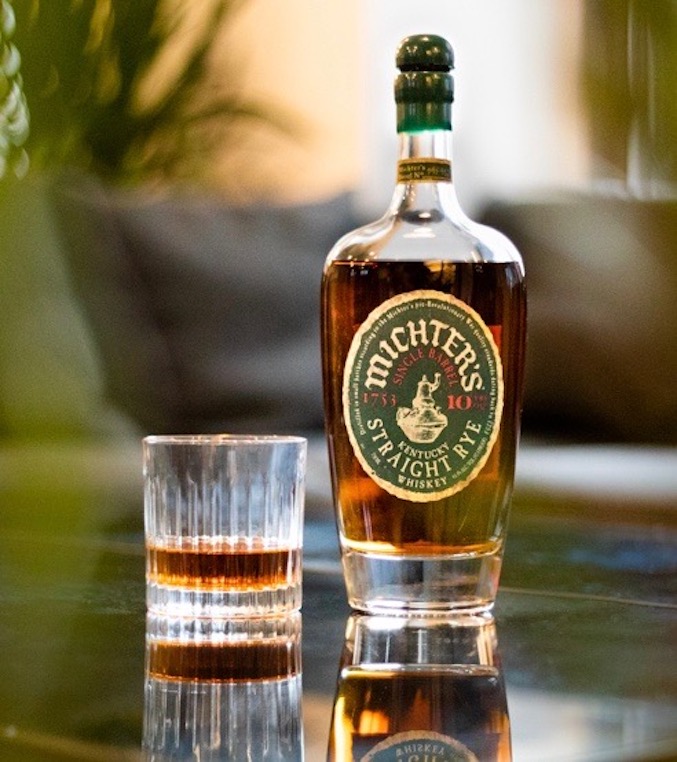 ($160)—For several years now Michter’s has been
a pioneer in experimenting with new styles of
bourbon and rye, and this one just came on the
market this month. They even have a “Master of
Maturation” (Andrea Wilson) who gives the final
sign-off on Master Distillers Pam Heilmann and
Willie Pratt’s production. There is some corn
and malted barley in with the rye to add
complexity, and that decade in barrel has given
it layers of nutty, faintly sweet flavors that
make it an
end-of-the-evening pleasure. Like most of
Michter’s labels, this is a limited edition and
will not be re-issued this year.
($160)—For several years now Michter’s has been
a pioneer in experimenting with new styles of
bourbon and rye, and this one just came on the
market this month. They even have a “Master of
Maturation” (Andrea Wilson) who gives the final
sign-off on Master Distillers Pam Heilmann and
Willie Pratt’s production. There is some corn
and malted barley in with the rye to add
complexity, and that decade in barrel has given
it layers of nutty, faintly sweet flavors that
make it an
end-of-the-evening pleasure. Like most of
Michter’s labels, this is a limited edition and
will not be re-issued this year.ADMIRAL RODNEY HMS PRINCESSA RUM ($50)—In more ways than one, this is quite a mouthful, a blend of rums aged between five and nine years in former bourbon and Port casks. It is named after Admiral George B. Rodney, who broke the French line at the Battle of the Saints off Jamaica in 1782, giving England control of the Caribbean sea lanes. Though not his ship, the HMS Princessa was crucial to the success of the attack. It’s a rum from St. Lucia, which is itself something of a rarity—the island only has three distilleries —and it has a rich mahogany color and sweet underpinnings. The blend is a little younger than the label’s two other rums and therefore a bit lighter on the palate.
D. GEORGE BENHAM BARREL FINISHED GIN ($44)—I know: Gin is usually a clear, colorless spirit, not brown. But this remarkable gin is actually a lovely gold color, not unlike what the original gins from the Netherlands looked like. The English lightened gin up, and since then the spirit is almost never aged. So Benham, out of California’s Sonoma County, comes as a happy surprise, for it really does have much more flavor than the usual gin, aging at least three months in 5-year-old Zinfandel wine barrels. As someone who is not much of a gin or martini drinker, this is one I could happily sip or mix with quinine and thoroughly enjoy all summer long.
WARRE’S OTIMA 10 YEAR OLD TAWNY PORT ($23)—I am also well aware that Port is not a brown spirit, though its deep reddish-brown color counts for something, and it’s a wine to be savored on its own, although it’s the ideal complement to cheese. As a tawny, it needs no decanting, and its decade of aging has really rounded out its considerable pleasures of big fruit, modest tannins, light caramel and warmth of character. Warre’s was the first British Port established in Portugal, and their products are known for their freshness. And what a great price for such a marvelous Port!
 KEEP THE CHANGE
KEEP THE CHANGE
Following a fight with her boyfriend, Serina Wolfe of Buffalo, NY,
used her boyfriend's credit card to get revenge
after they'd had a fight by tipping a waitress
in Clearwater Beach, FL, $5,000 on a $60 check.
Wolfe was charged by police with grand theft.
FOOD WRITING 101: BLOCK THOSE ADVERBS!
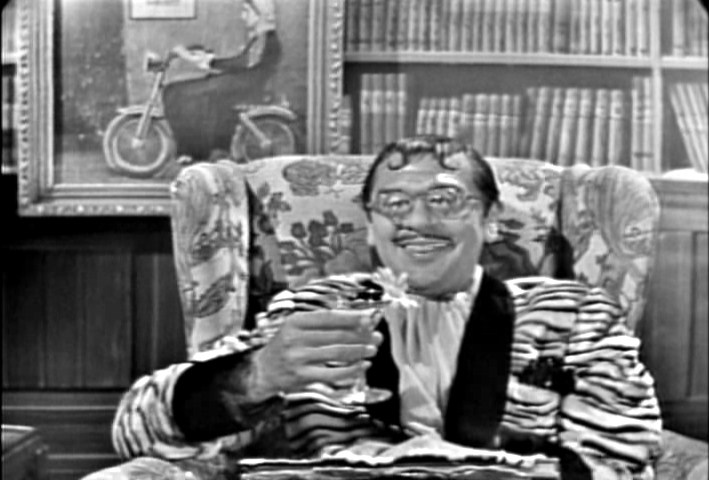
"Alluringly sweet with currants, allspice and
cinnamon. . ."
"The lamb’s job is to be obligingly tender. . . "
"The meat has been seasoned just
forcefully enough. . . "
"The butternut squash that has
been languorously baked in its own juices with
nothing but sugar. . . "
--Pete Welles, "At Lokanta,
Sheep’s Head Soup and Other Turkish Delights," NYTimes (7/3/19)
Any of John Mariani's books below may be ordered from amazon.com.
 The Hound in Heaven
(21st Century Lion Books) is a novella, and
for anyone who loves dogs, Christmas, romance,
inspiration, even the supernatural, I hope you'll find
this to be a treasured favorite. The story
concerns how, after a New England teacher, his wife and
their two daughters adopt a stray puppy found in their
barn in northern Maine, their lives seem full of promise.
But when tragedy strikes, their wonderful dog Lazarus and
the spirit of Christmas are the only things that may bring
his master back from the edge of despair.
The Hound in Heaven
(21st Century Lion Books) is a novella, and
for anyone who loves dogs, Christmas, romance,
inspiration, even the supernatural, I hope you'll find
this to be a treasured favorite. The story
concerns how, after a New England teacher, his wife and
their two daughters adopt a stray puppy found in their
barn in northern Maine, their lives seem full of promise.
But when tragedy strikes, their wonderful dog Lazarus and
the spirit of Christmas are the only things that may bring
his master back from the edge of despair. WATCH THE VIDEO!
“What a huge surprise turn this story took! I was completely stunned! I truly enjoyed this book and its message.” – Actress Ali MacGraw
“He had me at Page One. The amount of heart, human insight, soul searching, and deft literary strength that John Mariani pours into this airtight novella is vertigo-inducing. Perhaps ‘wow’ would be the best comment.” – James Dalessandro, author of Bohemian Heart and 1906.
“John Mariani’s Hound in Heaven starts with a well-painted portrayal of an American family, along with the requisite dog. A surprise event flips the action of the novel and captures us for a voyage leading to a hopeful and heart-warming message. A page turning, one sitting read, it’s the perfect antidote for the winter and promotion of holiday celebration.” – Ann Pearlman, author of The Christmas Cookie Club and A Gift for my Sister.
“John Mariani’s concise, achingly beautiful novella pulls a literary rabbit out of a hat – a mash-up of the cosmic and the intimate, the tragic and the heart-warming – a Christmas tale for all ages, and all faiths. Read it to your children, read it to yourself… but read it. Early and often. Highly recommended.” – Jay Bonansinga, New York Times bestselling author of Pinkerton’s War, The Sinking of The Eastland, and The Walking Dead: The Road To Woodbury.
“Amazing things happen when you open your heart to an animal. The Hound in Heaven delivers a powerful story of healing that is forged in the spiritual relationship between a man and his best friend. The book brings a message of hope that can enrich our images of family, love, and loss.” – Dr. Barbara Royal, author of The Royal Treatment.
 |
The Encyclopedia of American Food and Drink by John F. Mariani (Bloomsbury USA, $35) Modesty forbids me to praise my own new book, but let me proudly say that it is an extensive revision of the 4th edition that appeared more than a decade ago, before locavores, molecular cuisine, modernist cuisine, the Food Network and so much more, now included. Word origins have been completely updated, as have per capita consumption and production stats. Most important, for the first time since publication in the 1980s, the book includes more than 100 biographies of Americans who have changed the way we cook, eat and drink -- from Fannie Farmer and Julia Child to Robert Mondavi and Thomas Keller. "This book is amazing! It has entries for everything from `abalone' to `zwieback,' plus more than 500 recipes for classic American dishes and drinks."--Devra First, The Boston Globe. "Much needed in any kitchen library."--Bon Appetit. |
"Eating Italian will never be the same after reading John Mariani's entertaining and savory gastronomical history of the cuisine of Italy and how it won over appetites worldwide. . . . This book is such a tasteful narrative that it will literally make you hungry for Italian food and arouse your appetite for gastronomical history."--Don Oldenburg, USA Today. "Italian
restaurants--some good, some glitzy--far
outnumber their French rivals. Many of
these establishments are zestfully described
in How Italian Food Conquered the World, an
entertaining and fact-filled chronicle by
food-and-wine correspondent John F.
Mariani."--Aram Bakshian Jr., Wall Street
Journal.
"Equal parts
history, sociology, gastronomy, and just
plain fun, How Italian Food Conquered the
World tells the captivating and delicious
story of the (let's face it) everybody's
favorite cuisine with clarity, verve and
more than one surprise."--Colman Andrews,
editorial director of The Daily
Meal.com. "A fantastic and fascinating
read, covering everything from the influence
of Venice's spice trade to the impact of
Italian immigrants in America and the
evolution of alta cucina. This book will
serve as a terrific resource to anyone
interested in the real story of Italian
food."--Mary Ann Esposito, host of PBS-TV's
Ciao
Italia. "John Mariani has written the
definitive history of how Italians won their
way into our hearts, minds, and
stomachs. It's a story of pleasure over
pomp and taste over technique."--Danny Meyer,
owner of NYC restaurants Union Square
Cafe, The Modern, and Maialino.
|
 |
 |
 |
 |
 |
 |
 |
 |
 Everett Potter's Travel Report:
Everett Potter's Travel Report: 
 Eating Las Vegas
JOHN CURTAS has been covering the Las Vegas
food and restaurant scene since 1995. He is
the co-author of EATING LAS VEGAS – The 50
Essential Restaurants (as well as
the author of the Eating Las Vegas web site: www.eatinglasvegas.
He can also be seen every Friday morning as
the “resident foodie” for Wake Up With the
Wagners on KSNV TV (NBC) Channel 3 in
Las Vegas.
Eating Las Vegas
JOHN CURTAS has been covering the Las Vegas
food and restaurant scene since 1995. He is
the co-author of EATING LAS VEGAS – The 50
Essential Restaurants (as well as
the author of the Eating Las Vegas web site: www.eatinglasvegas.
He can also be seen every Friday morning as
the “resident foodie” for Wake Up With the
Wagners on KSNV TV (NBC) Channel 3 in
Las Vegas.
MARIANI'S VIRTUAL GOURMET
NEWSLETTER is published weekly. Publisher: John Mariani. Editor: Walter Bagley. Contributing Writers: Christopher Mariani,
Robert Mariani, Misha Mariani, John A. Curtas, Gerry Dawes, Geoff Kalish,
and Brian Freedman. Contributing
Photographer: Galina Dargery. Technical
Advisor: Gerry
McLoughlin.
If you wish to subscribe to this
newsletter, please click here: http://www.johnmariani.com/subscribe/index.html
© copyright John Mariani 2019

